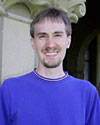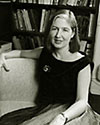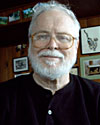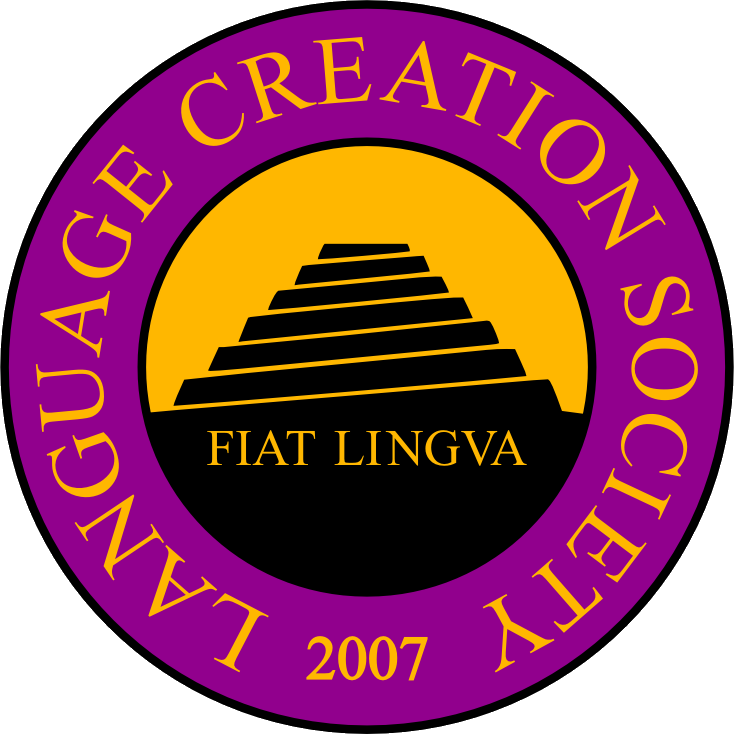LCC1 Talks and Panels
 Doug Ball |
Conlanging and the Linear Aspects of SyntaxThis talk will look at the ideas on linearization developed in Head-driven Phrase Structure Grammar (HPSG) and related frameworks. Starting from a traditional phrase structure view, it will be shown that the separation of linear precedence and dominance relations yields some previously uncaptured generalizations. Furthermore, it provides a way to see further generalizations about the ordering of words and phrases. I will discuss three of these generalizations: ordering of information-structure functions, ordering by “weight,” and ordering of arguments vis-à-vis their prominence on the thematic hierarchy. Thus, linearization offers another tool, beyond Greenbergian typology, to help conlangers design more natural language-like syntaxes for their conlangs.
|
| Doug Ball is originally from Colorado, where he was residing when he began work on Skerre at the age of 13. This language has been his conlanging focus for close to 12 years now, though he has worked on a few other, less involved, side projects over the years. He is currently a PhD candidate in the Department of Linguistics at Stanford University, where his research has focused on matters such as noun incorporation and argument realization in the Polynesian languages, and consonant clusters in the Native American language Wichita. | |
 Jeff Burke |
Language as Growth-in-TimeWhen we first learn foreign languages, we’re often introduced to a way of thinking that’s dangerous to understanding what a language actually is and how it works: questions of “why” directed at baroque inflectional or conjugational systems are answered with a curt “because it’s just that way.” But there’s almost always a good reason why, and that why lies in the history of the language. I’ll be discussing language as growth-in-time, as opposed to a static entity, and what implications this has for conlangers whose aim is naturalistic languages. In addition to sound change, I’ll also cover changes driven by conceptual shifts among speakers of a language, with the development of the four-way gender distinction in Iroquoian as a paradigm case. Study (PDF) | Correspondences (PDF) | Handout 1 (JPG) | Handout 2 (JPG) | Handout 3 (JPG) | Handout 4 (JPG) | Handout 5 (JPG) | Handout 6 (JPG) | Handout 7 (JPG) | Handout 8 (JPG) |
| Jeff S. Burke is from central Indiana, and holds a BA in Music from Ball State University in Muncie, Indiana. He has worked as a sound engineer for the last five years in the Indianapolis area. Among his many interests are the Algonquian and Iroquoian language families, which he has spent more than a decade studying and lusting after in his quest to build a conlang family of his own. | |
 Sally Caves |
The Medium and the Internet Conlanger: Vision, Venue, and PlayIn this talk I will generally examine what we do on the Internet in the way of “playing.” My term “medium” is double-edged in that I refer both to the famous medium Héléne Smith, and the media by which we we air this new activity (old, actually, but not given the means by which fellow inventors can confer and interact as we do now). How has the Internet both expanded and closeted what we do? Why is inventing a language something outsiders associate with child’s play? Why was Hildegard a “serious” conlanger but not Smith who was deemed hysterical and regressive? How have various media, combined with social attitudes, shaped the way in which we engage ourselves in this pursuit and how we (and outsiders) perceive it? With these and other questions, I can be freer in this conference of fellow conlangers to wear both my hats–as language inventor and scholar of language invention–and thus reveal what it is I think I’m doing now, what I thought I was doing before I came upon CONLANG, and where I see myself and the rest of you in these overlapping continua of play, language, art, self-expression, and system. |
| B.A. in English from Scripps College, 1975, Ph.D. from Berkeley in 1983, Fulbright Hays Grant to Wales; taught at the University of Geneva, Switzerland, from 1984-1986, and at the University of Rochester, NY from 1986 to present. Author of Between Languages: Old English and Early Welsh Poetry, Penn State 1993; co-editor of a volume of essays: Nothing That Is: Millennial Cinema and the Blair Witch Controversies, Wayne State, 2004; published articles on Old and Middle English, Middle Welsh, Old Norse, teratology, science and mythology, television and film studies, conlanging; book on Hildegard of Bingen’s Lingua Ignota under scrutiny at Palgrave; work in progress on A Genealogy of Language Invention. Published science fiction and fantasy, and two aired teleplays (Star Trek: TNG and Star Trek: DS9). Interests: art, calligraphy, book-making, creative writing, singing, composition. | |
 John E. Clifford |
Semantic Primes: aUI to Esperanto with Stops Along the WaySemantic primes are units of meaning, presumably relatively few in number (relative to the OED anyhow), in terms of which “all” other meanings can be defined. That there must be such things has been known since defining began to be studied and they were early involved in created languages (histories always offer up typographical horrors from the 17th century, e.g., Urqhart’s). We will look at how this notion plays out in a few modern created languages: aUI, in which it is of central importance, informing word construction as well as semantic; toki pona, in which the notion is not explicit but is clearly active in vocabulary choice; Lojban (and Loglan), in which the notion is rejected in favor of semantic primitives, a larger list which are still meant to allow defining everything else, but which may themselves also be defined; and Esperanto, in which the notion plays almost no role at all. We shall also look at the notion in the context of scientific linguistics, where the Natural Semantic Metalanguage (NSM) program is attempting to find the semantic primes of various languages in the hope of developing a list which works for all languages. This search is obviously an empirical one, while many created languages use an apriori (or intuitive) approach to selecting primes. These approaches as well as the limitations on techniques for forming definitions using primes are topics we take up. Along the way we will look at how vocabulary is related to meaning units, at some problems that proposed systems of primes run into, and at an emreging set of primes and definition techniques.
|
| John E. Clifford (Parks-Clifford — whence his sobriquets in Loglan and Lojban, pc and pycyn — for the duration of one wife) received a BA from Michigan State, then spent a year at Princeton before settling in at UCLA for a decade. In that time he acquired an MA in Linguistics and a PhD in Philosophy (dissertation on natural language tense and tense logic). He spent 33 years in the Philosophy Department of the University of Missouri – St. Louis, teaching Logic (from Critical Thinking through Goedel), Asian Philosophy, and Philosphy of Religion , and occasionally other things that needed teaching. He was an Esperantist from his second year at Exeter, though mainly lapsed. He first worked with Loglan in 1960 (after the Scientific American article) as a contribution to the machine translation program at RAND. When Loglan reemerged in 1975, he reupped, becoming the first editor of The Loglanist, a member of the board of The Loglan Institute and eventually Vice-President, then President. He joined the Logical Language Group in the mid-80s and has participated actively in the development of Lojban, mainly advocating more logic in keeping with his early exposure — under Carnap and the like — to the notion of a logically perfect language. He was involved with aUI while sabbaticating on Iowa and has recently taken up toki pona and a good old Logical Positivist examination of NSM. He is still looking for an empirically testable hypothesis that comes close to the informal proposals of Sapir and Whorf. | |
 Sai |
Non-Linear Fully 2-Dimensional Writing SystemsAll natural writing systems are linear; they can be arranged as a purely arbitrary sequence of symbols in a string with no loss of meaning. This talk explores the idea of non-linear writing systems – design considerations, desirable features, psychological ramifications, problems that would need to be addressed, potential implementations, and what they would have to offer that linear languages are intrinsically incapable of doing. |
| Sai is the sole organizer of this conference, two-time teacher of the Conlangs DE-Cal course, and founder of the LiveJournal Conlangs community. He is finishing his B.A. in Cognitive Science at UC Berkeley, with plans to move to Japan and teach English in the near future. Sai can converse in English, Russian, Spanish, French, American Sign Language, and Japanese, and has some rusty knowledge of Mandarin and Arabic. He is currently employed as a consultant by Medtronic Inc., working on nondisclosable international projects; former jobs have included database design, systems administration, SAT tutoring, programming, and massage therapy. He currently lives in Oakland CA with his roommate and cat, and is interested such things as wordplay, massage, empathy, music, good food, computers, neuroscience, linguistics, meditation, hiking, energy work, and (of course) in seeing how far the boundaries of language creation can be pushed – with an eye towards effecting cognitive change and empowerment. | |
 Matt Pearson |
Case, Aspect, and Argument Structure: One Conlanger’s InvestigationsThis talk explores case and agreement systems in different |
| Matt Pearson is an assistant professor of linguistics at Reed College, in Portland, Oregon. He specializes in syntactic theory and cross-linguistic variation, with an emphasis on the structure of Malagasy. He has been creating artlangs, and collecting examples of artlangs from SF/F literature, for many years. While completing his PhD at UCLA, Matt was hired to design the alien ‘hive’ language for the short-lived NBC show “Dark Skies”, and also did dubbing and dialogue coaching for the show. | |
 David Peterson |
Down with Morphemes: What Word and Paradigm Morphology Can Teach Us About Language CreationIn any introductory linguistics class, the student is taught that a morpheme is the smallest unit of meaning in a language. Thus, in a word like “cats”, one combines the morpheme “cat” (meaning “cat”) and the morpheme “-s” (meaning “plural”) to get “cats” (meaning “more than one cat”). Under the morpheme-based account of language, meaning is merely strung together like beads on a string, and is in a one-to-one correspondence relationship with more or less fixed phonological entities (i.e., roots and affixes). Thus, to explain a language, in a morpheme- based theory, all one has to do is come up with a list of roots and affixes, and rules on how to combine them. Whether this view of language is accurate or not is not relevant to language creation, per se. What is relevant is how useful a morpheme-based account is to language creation. In this talk I will argue that a morpheme-based account of language is detrimental to the creation of a naturalistic language. As an alternative, I will summarize the basic principles behind Word and Paradigm Morphology–a non-morpheme-based approach to linguistic analysis–and demonstrate how the insights gained from Word and Paradigm Morphology can help to create a more naturalistic conlang. After all, as the present/past tense pair “take”/”took” shows, creating a language is more complicated — and far more interesting — than merely coming up with a list of roots and affixes. |
| David J. Peterson received BA’s in English and Linguistics from UC Berkeley, where he discovered language creation via a class on Esperanto. Since then, he’s made it a goal of his to learn more about language and linguistics in order to create more naturalistic languages. He’s the author of seven or so languages (among them Zhyler and Kamakawi), and is currently a graduate student of linguistics at UCSD. | |
 John Quijada |
Applying Concepts from Cognitive Linguistics to Your ConlangA brief introduction to the basic history and premises of cognitive linguistics will be provided (“grammar as conceptualization”, i.e., that grammar is merely a reflection of generic cognitive processes as applied to language). The focus of the presentation is to demonstrate the importance of understanding/applying basic concepts of cognitive linguistics to increase the “realism” and individuality of a conlang, and to help avoid inadvertently mirroring the subconscious linguistic patterns of one’s native language when designing a conlang. Specific topics to be discussed and illustrated with particular focus on how they can impact the design of a conlang include (1) construal, perspective, and iconicity; (2) image schemas and spatial conceptualization; (3) prototypes and fuzzy categories; (4) conceptual metaphors; (5) frame semantics; (6) polysemy.
|
| John Quijada is the creator of Ithkuil, a philosophical language he worked on over the course of 25 years (before any internet or any realization on his part that there were other conlangers in the world besides Tolkien, Ursula LeGuin, and Christian Vander). Ithkuil has gained a fair degree of notoriety among conlangers and others since its debut on the Web two years ago. Ithkuil is particularly popular in Russia after being featured in a Russian-language popular science magazine article; in fact, one fan has recently completed posting of a Russian translation of the Ithkuil website. John has a degree in linguistics, speaks five languages, and has just finished co-authoring a novel with his brother exploring the philosophical implications of quantum physics and cognitive science. In addition to conlanging, he enjoys a wide range of hobbies and pastimes including travel, gourmet cooking, eclectic literature, sci-fi, classical and world music, art, art-house cinema, electronic (MIDI) music synthesis, amateur astronomy, amateur protozoology, and cats. | |
Panel: Conlang TeachingIn recent years, language creation has started to be taught in earnest at the college level. This panel will discuss the future of conlanging classes, how they could be used to teach introductory and advanced linguistics, creative writing, etc., and the panelists’ experiences with teaching, participating in, or behind-the-scenes lobbying on behalf of such classes. |
|
Panel: Conlang AestheticsWithin the field of language creation, there are many different specialties. This panel will discuss what they are, and what the goals, desiderata, and aesthetics are of the various “schools” of conlanging. |
|
